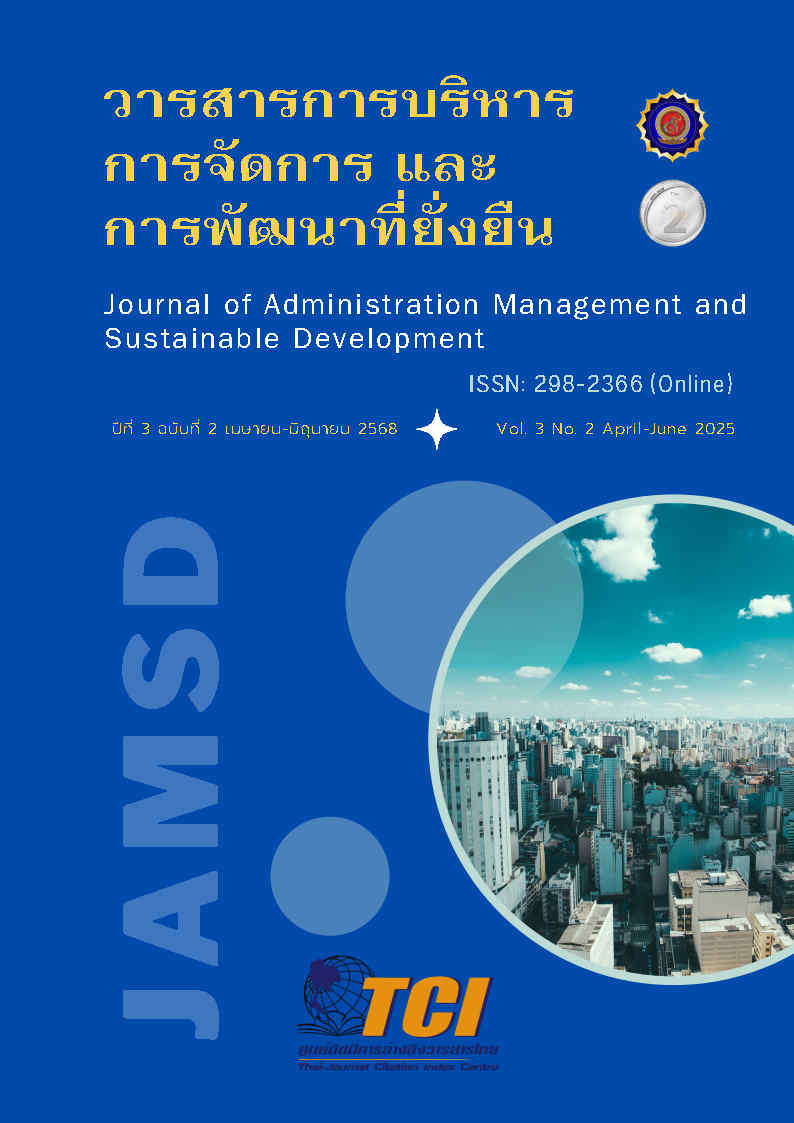กลยุทธ์ส่วนประสมทางการตลาดเพื่อความได้เปรียบเชิงการแข่งขันธุรกิจคอนกรีตผสมเสร็จ ของบริษัท เซ็นเตอร์โปร คอนกรีต ในเขตจังหวัดอุดรธานี
คำสำคัญ:
กลยุทธ์ส่วนประสมทางการตลาด, ความได้เปรียบเชิงการแข่งขัน, ธุรกิจคอนกรีตผสมเสร็จบทคัดย่อ
การวิจัยครั้งนี้ มีวัตถุประสงค์ เพื่อศึกษาระดับความคิดเห็นต่อส่วนประสมทางการตลาดและความได้เปรียบเชิงการแข่งขันฐานการมุ่งเน้นลูกค้าสำหรับธุรกิจคอนกรีตผสมเสร็จของบริษัท เซ็นเตอร์โปร คอนกรีต จำกัด ในเขตจังหวัดอุดรธานี และเพื่อศึกษากลยุทธ์ส่วนประสมทางการตลาดที่ส่งผลต่อความได้เปรียบเชิงการแข่งขันธุรกิจ การเก็บข้อมูลโดยการใช้แบบสอบถาม 96 ชุด จากการสุ่มตัวอย่างแบบไม่ใช้ความน่าจะเป็น และใช้วิธีการสุ่มตัวอย่างด้วยเทคนิควิธีอาศัยความสะดวกกับกลุ่มตัวอย่าง คือ ลูกค้าของบริษัท ที่อาศัยอยู่ในจังหวัดอุดรธานี ทำการวิเคราะห์ข้อมูลโดยใช้สถิติเชิงพรรณนาด้วยค่าความถี่ ร้อยละ ค่าเฉลี่ย ส่วนเบี่ยงเบนมาตรฐาน และสถิติเชิงอนุมาน ใช้การวิเคราะห์ความถดถอยเชิงพหุคูณที่ระดับความเชื่อมั่น 95% ผลการวิจัยพบว่า กลยุทธ์ส่วนผสมการตลาดด้านกายภาพมีอิทธิพลสูงสุดต่อความได้เปรียบเชิงการแข่งขันธุรกิจคอนกรีตผสมเสร็จในเขตจังหวัดอุดรธานี รองลงมาได้แก่ ด้านส่งเสริมการตลาด ด้านบุคลากร และ ด้านการให้บริการ นอกจากนี้ ผลการวิเคราะห์ความสัมพันธ์ระหว่างตัวแปร ชี้ให้เห็นว่า กลยุทธ์สวนประสมการตลาดที่ส่งผลต่อความได้เปรียบเชิงการแข่งขัน อย่างมีนัยสำคัญที่ระดับ 0.05 ได้แก่ กลยุทธ์สวนประสมการตลาดด้านภายภาพ ด้านช่องทางการจัดจำหน่าย และด้านการส่งเสริมการตลาดตามลำดับ
เอกสารอ้างอิง
เกริกฤทธิ์ อินแถลง และธนกร สิริสุคันธา. (2565). ส่วนประสมทางการตลาดที่มีต่อความพึงพอใจในการใช้บริการธุรกิจคอนกรีตผสมเสร็จในเขตอำเภองาว จังหวัดลำปาง. วารสาร มจร อุบลปริทรรศน์, 7(1), 561–574. https://so06.tci-thaijo.org/index.php/mcjou/article/view/255460.
ชลวิทย์ วรรณโชติผาเวข. (2560). ปัจจัยที่มีผลต่อความพึงพอใจในการซื้อคอนกรีตผสมเสร็จ. การค้นคว้าอิสระบริหารธุรกิจมหาบัณฑิต มหาวิทยาลัยธรรมศาสตร์.
บุญชม ศรีสะอาด. (2535). การวิจัยเบื้องต้น. กรุงเทพฯ: สุวีริยาสาส์น.
สืบชาติ อันทะไชย (2556). การบริหารการตลาด. กรุงเทพฯ: โอเดียนสโตร์.
Caliskan, A., Özkan Özen, Y. D., & Ozturkoglu, Y. (2021). Digital transformation of traditional marketing business model in new industry era. Journal of Enterprise Information Management, 34(4), 1252–1273. https://doi.org/10.1108/JEIM-02-2020-0084.
Cui, Y. (Gina), van Esch, P., & Phelan, S. (2024). How to build a competitive advantage for your brand using generative AI. Business Horizons, 67(5), 583–594. https://doi.org/10.1016/j.bushor.2024.05.003.
Dadzie, K. Q., Amponsah, D. K., Dadzie, C. A., & Winston, E. M. (2017). How Firms Implement Marketing Strategies in Emerging Markets: An Empirical Assessment of The 4A Marketing Mix Framework. Journal of Marketing Theory and Practice, 25(3), 234–256. https://doi.org/10.1080/10696679.2017.1311220.
Dung Ngo, V., Leonidou, L. C., Janssen, F., & Christodoulides, P. (2024). Export-specific investments, competitive advantage, and performance in Vietnamese SMEs: The moderating role of domestic market conditions. Journal of Business Research, 170, 114315. https://doi.org/10.1016/j.jbusres.2023.114315.
Ghezali, F., & Boudi, A. (2021). The moderating effect of information technology capabilities on the relationship between marketing mix and corporate entrepreneurship. PSU Research Review, 5(2), 101–119. https://doi.org/10.1108/PRR-12-2019-0037.
Grönroos, C. (2020). Viewpoint: service marketing research priorities. Journal of Services Marketing, 34(3), 291–298. https://doi.org/10.1108/JSM-08-2019-0306.
Hajjat, M. M. (2002). Customer orientation: construction and validation of the CUSTOR scale. Marketing Intelligence & Planning, 20(7), 428–441. https://doi.org/10.1108/02634500210450864.
Hossain, M. A., Agnihotri, R., Rushan, M. R. I., Rahman, M. S., & Sumi, S. F. (2022). Marketing analytics capability, artificial intelligence adoption, and firms’ competitive advantage: Evidence from the manufacturing industry. Industrial Marketing Management, 106, 240–255. https://doi.org/10.1016/j.indmarman.2022.08.017.
Ivy, J. (2008). A new higher education marketing mix: The 7Ps for MBA marketing. International Journal of Educational Management, 22(4), 288–299. https://doi.org/10.1108/09513540810875635.
Kwan, Y. K. C., Chan, M. W., & Chiu, D. K. W. (2023). Youth marketing development of special libraries in the digital era: viewpoint from the Taste Library with 7Ps marketing mix. Library Hi Tech, 42(6), 1740-1759. https://doi.org/10.1108/LHT-03-2023-0129.
Lim, W. M. (2021). A marketing mix typology for integrated care: the 10 Ps. Journal of Strategic Marketing, 29(5), 453–469. https://doi.org/10.1080/0965254X.2020.1775683.
Liu, Y., Mayerhofer, T. J. H., Marchand, A., Foscht, T., Fritze, M. P., & Eisingerich, A. B. (2024). Is there a danger of making customers feel too empowered? Exploring the double-edged sword of customer orientation and creative benefits. European Journal of Marketing, 58(11), 2393-2425. https://doi.org/10.1108/EJM-12-2021-0925.
Mahajan, P., & Golahit, S. (2020). Service marketing mix as input and output of higher and technical education: A measurement model based on students’ perceived experience. Journal of Applied Research in Higher Education, 12(2), 151–193. https://doi.org/10.1108/JARHE-01-2019-0022.
Modi, P., & Sahi, G. K. (2024). Balancing customer and employee orientations: impact on financial distress and firm value. Marketing Intelligence and Planning, 42(8), 1353–1383. https://doi.org/10.1108/MIP-12-2023-0664.
Navarro-García, A., Ledesma-Chaves, P., Gil-Cordero, E., & De-Juan-Vigaray, M. D. (2024). Intangible resources, static and dynamic capabilities and perceived competitive advantage in exporting firms. A PLS-SEM/fsQCA approach. Technological Forecasting and Social Change, 198, 123001. https://doi.org/10.1016/j.techfore.2023.123001.
Olsen, L. L., Witell, L., & Gustafsson, A. (2014). Turning customer satisfaction measurements into action. Journal of Service Management, 25(4), 556–571. https://doi.org/10.1108/JOSM-01-2014-0025.
Othman, B. A., Harun, A., De Almeida, N. M., & Sadq, Z. M. (2021). The effects on customer satisfaction and customer loyalty by integrating marketing communication and after sale service into the traditional marketing mix model of Umrah travel services in Malaysia. Journal of Islamic Marketing, 12(2), 363–388. https://doi.org/10.1108/JIMA-09-2019-0198.
Papadas, K. K., Avlonitis, G. J., Carrigan, M., & Piha, L. (2019). The interplay of strategic and internal green marketing orientation on competitive advantage. Journal of Business Research, 104, 632–643. https://doi.org/10.1016/j.jbusres.2018.07.009.
Pekovic, S., & Rolland, S. (2016). Customer orientation and firm’s business performance: A moderated mediation model of environmental customer innovation and contextual factors. European Journal of Marketing, 50(12), 2162–2191. https://doi.org/10.1108/EJM-08-2015-0584.
Porter, M. E. (1990). The competitive advantage of nations. Free Press.
Singh, R., & Koshy, A. (2012). A new conceptualization of salesperson’s customer orientation: Propositions and implications. Marketing Intelligence and Planning, 30(1), 69–82. https://doi.org/10.1108/02634501211193921.
Thoumrungroje, A., & Racela, O. C. (2022). Innovation and Performance Implications of Customer-Orientation across Different Business Strategy Types. Journal of Open Innovation: Technology, Market, and Complexity, 8(4), 178. https://doi.org/10.3390/joitmc8040178.
Woehler, J., & Ernst, C. (2023). The importance of marketing mix planning and customer orientation for venture capital–financed startups: impacts on valuation, performance, and survival. Journal of Research in Marketing and Entrepreneurship, 25(1), 1–25. https://doi.org/10.1108/JRME-08-2021-0098.



